FORCED LABOR CAMP SHOCKS U.S. ARMY LIBERATORS
Ohrdruf, Central Germany • April 4, 1945
Over the first 3 weeks of April 1945, during the brutal terminal phase of Adolf Hitler’s Third Reich, Allied armies discovered more than 100 concentration and extermination camps, including Buchenwald, Nordhausen, Flossenbuerg, and Bergen-Belsen. Discoveries like these came mostly by accident because sites of this nature were not marked on the military maps the Allies were using. So it was that on this date, April 4, 1945, soldiers of Gen. George S. Patton’s Fourth Armored Division, U.S. Third Army, unexpectedly came upon the ghastly scene of the mostly deserted Ohrdruf forced labor camp, Stalag Nord Ohrdruf, a small Buchenwald subcamp established the previous October. Later in the day more of Patton’s soldiers, men from the 89th and the 355th Infantry Divisions, arrived on the scene and were unnerved by what they saw.
The original mission of Patton’s men had been to search south of Gotha in Thuringia (German, Thueringen), South-Central Germany, for a secret, last-ditch underground bunker that reputedly was to house a new Fuehrer headquarters for Hitler and his staff. A report from one of the camp liberators reached Generals Dwight D. Eisenhower, Omar Bradley, and Patton as they visited a nearby salt mine where the Nazis had stored $250 million in gold bars, currency, and art treasures.
After lunch on April 12 the generals and their entourage visited the Ohrdruf camp, the first Nazi prison camp U.S. servicemen had discovered on German soil and the first they liberated while it still had inmates living inside its barracks, huts, tents, and horse stables. At the top of the month between 11,700 and 13,000 inmates were held in the camp, but as U.S. troops rapidly advanced toward Ohrdruf nearly 10,000 prisoners were force-marched 32 miles/51 kilometers to the Buchenwald main camp, a nightmarish, 3‑day journey during which an estimated 1,000 prisoners were shot or beaten to death or died from exhaustion. Dressed in rags, Ohrdruf’s survivors were practically skin and bones, emaciated from the effects of starvation and disease. Week-old corpses of prisoners in the roll-call square and elsewhere in the camp—an estimated 3,200 corpses—caused battle-hardened Patton to lose his lunch out of the sight of news cameras. It also caused him to order townspeople from Ohrdruf, which lay a mile/1.6 kilometers away, to tour the “horror camp” and see for themselves the crimes committed by their compatriots. Patton’s order was repeated at Buchenwald, Dachau, and other camps liberated by American soldiers and by at least 1 Soviet commanding officer who directed German inhabitants of villages surrounding the notorious women’s concentration camp at Ravensbrueck north of Berlin to tour that facility.
A few weeks later Eisenhower established a POW camp in nearby Gotha, where he had made his headquarters, to house SS officers, camp guards and doctors, and prisoner-functionaries who had served at Nazi labor and death camps. Many were sentenced by Allied military tribunals to long prison terms or death based on the evidence collected during Allied walk-throughs and eyewitness testimonies.
Liberated Nazi Forced Labor Camp at Ohrdruf, Central Germany, Visited by U.S. Generals and Nearby Townspeople
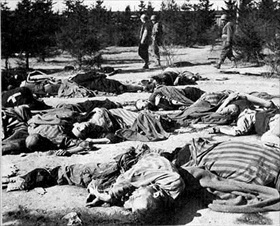 | 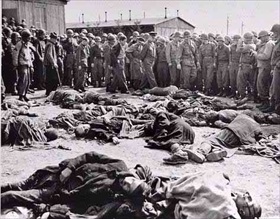 |
Left: U.S. soldiers were totally unprepared psychologically for what they found at the Ohrdruf forced labor camp. The encounter would haunt most of the men for the rest of their lives. Corpses at the camp gate still lay unburied, lice crawling over their yellow skin. The smell of death, urine, and feces hung everywhere in the air. Survivors testified that the dead had been shot at close range by SS guards on April 2 because the Germans had run out of trucks for evacuating sick or disabled prisoners as the Americans closed in on the prison camp. Many of the dead had been so emaciated and malnourished that the bullet wounds in their skulls had not even bled.
![]()
Right: Twenty-one generals and their staffs toured Ohrdruf on April 12, 1945. Some members of the entourage were unable to go through with the ordeal. On April 19, 1945, Eisenhower wired both Washington and London to quickly dispatch journalists, members of Congress, and British parliamentarians to Ohrdruf to dispel any allegations that the stories of Nazi brutality were merely propaganda. American newsreels of Ohrdruf called the camp a “murder mill.” (See YouTube video below.)
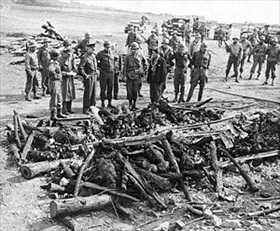 | 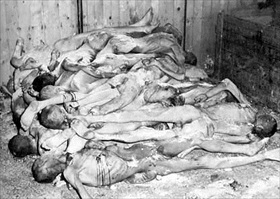 |
Left: Generals Eisenhower, Bradley, Patton, and Manton Eddy, among others, view the charred remains of prisoners who had been doused with pitch and burned on “a mammoth griddle” (Patton’s words) fashioned from crisscrossed railroad track laid over coal and pinewood logs. Long poles with steel hooks on them were used for turning the bodies over. The bodies were still there, some only charred, some half burnt. Below the bodies was a pit in which lay a pile of bones, skulls, and charred torsos. The operation had been done during the evacuation of Ohrdruf by retreating camp officers, guards, and staff. The scene before Patton reminded him of “some giant cannibalistic barbecue.” Remembering their walk through the camp, Bradley remarked how “the smell of death overwhelmed us.” When a camp guard showed Eisenhower how some starved prisoners had torn out the entrails of the dead for food, the general’s face, Bradley wrote, “whitened into a mask.” Bradley was struck dumb, “too revolted to speak.” The camp guard also showed the generals a gallows where men were hanged for attempting to escape. “The hanging was done by a bit of piano wire,” Patton dictated in a memo, “and the man being hanged was not dropped far enough to break his neck but simply strangled.”
![]()
Right: Nude bodies of 40 starved prisoners in a shed at Ohrdruf were layered with lime to mitigate the smell. Patton described the shed as “the most appalling sight imaginable.” When the shed was packed full (about 200 bodies), its contents would be taken to a pit a mile/1.6 kilometers from the camp and buried. Surviving prisoners told Patton that 3,000 of their number had died in the camp since January 1, 1945.
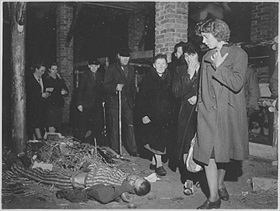 | 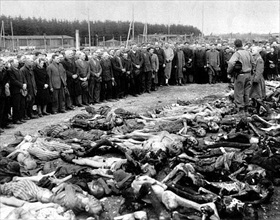 |
Left: Soon after visiting Ohrdruf, Gen. Eisenhower ordered every nearby unit not on the front lines to tour Ohrdruf so that the average GI would understand not just what he was fighting for but “he will know who he is fighting against.” To drive the point home and to “brief” GIs on what they might run into in the weeks ahead, photographs from concentration camps like Ohrdruf were distributed to soldiers. On the orders of Eisenhower himself, the mayor of the German town of Gotha, located next to the Ohrdruf complex, toured the camp to see the display of corpses. After seeing the horror, the mayor, professing no knowledge of the affairs of the camp, went home and he and his wife slashed their wrists before hanging themselves. (Without knowing the couple’s motivation, Eisenhower interpreted their suicides as remorse or repugnance for Germany’s past criminal acts and a positive omen for moving Germany forward.) As a rule camp liberators recoiled in disbelief when they heard the perpetual lament of visiting townspeople, who gaped in horror at the piles of decaying bodies and breathed in their putrid stench: “Wir wussten nicht.” (We didn’t know.) “Niemand sagte uns.” (No one told us.) The object of what Germans didn’t know or weren’t told (the missing “it” in sentences like these) was belied most often by the 1‑way traffic of tens of thousands of locked cattle cars leaving from or passing through German cities, towns, and villages to destinations in the East and the sooty smoke rising from crematoria chimneys everywhere in the Reich. Conceivably some of the townspeople and others like them in this picture who solemnly swore they didn’t know or were never told were the same people who years or months or weeks earlier had jeered, hurled insults, and spat on people taken into Nazi custody—people who tragically ended up dead on a crematorium floor like this in the picture.
![]()
Right: American soldiers forcibly trucked 100 or so Ohrdruf townspeople each day to the “pesthole,” as Patton called the camp, to exhume the bodies in the mass grave and bury them again in individual graves in a public place. A policy Eisenhower mandated required that a stone monument be erected nearby to commemorate the “atrocity victims.” At another reinterment site at Orhdruf’s main camp, Buchenwald, an American officer took no pity on 200 Germans complaining of the stench of decomposed corpses and the day’s heat. “Dig, you sons of bitches,” was all he could say. At some locations German civilians were ordered to feed, clothe, and house liberated prisoners at their own expense.
“Liberators and Survivors: The First Moments,” Produced by The International School for Holocaust Studies
![]()

 History buffs, there is good news! The Daily Chronicles of World War II is now available as an ebook for $4.99 on Amazon.com. Containing a year’s worth of dated entries from this website, the ebook brings the story of this tumultuous era to life in a compelling, authoritative, and succinct manner. Featuring inventive navigation aids, the ebook enables readers to instantly move forward or backward by month and date to different dated entries. Simple and elegant! Click
History buffs, there is good news! The Daily Chronicles of World War II is now available as an ebook for $4.99 on Amazon.com. Containing a year’s worth of dated entries from this website, the ebook brings the story of this tumultuous era to life in a compelling, authoritative, and succinct manner. Featuring inventive navigation aids, the ebook enables readers to instantly move forward or backward by month and date to different dated entries. Simple and elegant! Click 











